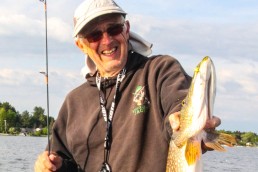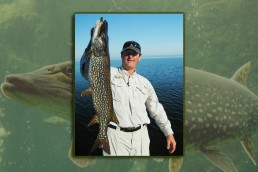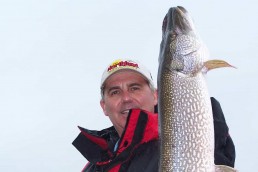Holiday and Harvest Time Pike
SHARE THIS POST
Once Halloween rolls around, most anglers have quit for the season. This is the time for big pike. When the lakes start their fall turnover, pike go on a prowl. Big, mean pike will attack large baits with reckless abandon.
“Fall is one of my favorite times to chase down big pike,” said John Cleveland, marketing director of Eppinger/Dardevle spoon company. John stated that spoons are the easiest lure to tease a pike into hitting. You can bounce then off of structure or objects, can jerk or jig a spoon in, flutter it down a steep break line or weed line, and can slow-roll it just under the surface over a green weedbed.
The 1-ounce size, which is 4 inches long, is a popular and go-to lure with many pike diehards. Some will tip it with a Mr. Twister tail. We remove the treble hooks and replace them with a 3/0 single hook. We lose less fish, and enjoy a higher hook-up ratio with the single hook.
John suggested using 30-pound braid, with either a 30-pound fluorocarbon leader or a 12-inch titanium leader, when monster pike are around. On lakes with smaller pike, you can go with 15-pound or 20-pound braid and leaders. What are John’s three favorite colors, you ask? Red/White with a cooper back, the 5 of Diamonds with a brass back, and the Black spoon with a white stripe.
“I like a slow retrieve once the water turns cool, and anglers really need to pay attention to this, because many of the newer reels have a superfast gear ratio,” said Cleveland. Vary your retrieve, throw in a few stop-and-pauses.
John likes to target any green weeds that can be found, and the first drop-off close to the weeds. Another good option is any steep break lines where the depth plunges quickly into deep water. On Muskegon and White Lakes, there are weedbeds that border very fast drop-offs. We love these locations.
Dan Hassevort, a guide, tournament angler and marketing marvel from West Michigan, loves trolling planner boards. Dan will run Mag Lips and Fore Play crankbaits on the fall pike. The Fore Play, without a doubt is his favorite.
“We search out the edges of the weeds and the edges of the drop-offs concentrating on the fish that are high up in the water column. Anglers can sleep in on these late fall days; the best action starts mid- morning,” said Hassevort.
Daryl Christensen is perhaps one of the best-known spoon and jig fishermen that the angling world has known. Daryl searches out the same types of locations, and the jigging spoon his go-to lure. He loves fishing where shad or alewives are found, dead or alive! He also loves steep breaklines in the fall.
The Hopkins spoon is his go-to spoon, and he never adds anything to the spoon. And, no braid—purely mono—when fishing spoons. Ten-pound up to 14-pound mono can be used. His exception, a 4-inch steel leader is added when large toothy critters are present, like pike or muskies.
You will find Daryl casting a spoon nearly 100 percent of the time. Only in the winter would he consider vertical jigging. Regardless of the water depth, be it 8 feet or 80 feet, cast it, let it settle to the bottom, pop it two to three times, reel in the slack, let it drop, pop-it a few times, let it drop, and continue until the spoon is nearly vertical under the boat.
“In dark water, I like a gold spoon; silver on the Great Lakes, or in clear waters,” said Christensen. Hook a snap to your line. One tip Daryl shared: Don’t be surprised at the number of fish that will grab your spoon and hang onto it when it is fluttering down. When you lift to pop the spoon, there will be a heaviness. Reel fast, and set the hook.
Fall fishing would not be complete without mentioning Mepps Spinners. I love throwing big bucktail spinners—the #5 bucktail being my smallest to throw. Often, I toss a Mepps Giant Musky Killer. Some days, we add a Mr. Twister tail to the spinner.
Are you enjoying this post?
You can be among the first to get the latest info on where to go, what to use and how to use it!
Weighing down the spinner dramatically improves the fishing. These spinners have a tendency to run high, and while bulging the surface works great throughout much of the season, I found that keeping the bait down 2 to 4 feet works best during fall.
While I’m a fan of bright colors or white during spring and summer, hands-down the top fall color choice becomes black or brown. The addition of some orange makes for a deadly combination.
Spinners are best used on the remaining green weeds, and on the beginning of a drop-off. Best depths can range between 2 feet and, say, 12 or 14 feet of water. We normally start over the tops of the weeds, often creating a bulge on or just slightly below the surface.
After working a few casts over the tops, we helicopter the spinner down the deep side of the weeds. Last, cast out, let it sink to the bottom, and then start doing a pumping action, with a slow retrieve.
Another very good lure/bait combination is the Bait Spin from Gopher Tackle. The more that I fish pike, the more I believe this to be a true bread-and-butter bait. It’s like money in the bank when you learn all of the ways that it can be fished. This is a hard bait to find.
You can go with a Northland tackle short-arm spinner. This small spinner comes in all of the popular color and weight choices. Tip the spinner with a plastic tail, or with a large lively redtail chub, and fish it in the same manner as you would a jig.
Most of your strikes will happen as it helicopters down, or just as it hits the bottom. When fishing other baits, always try this rig before moving. At times, there will be fish that will not hit the other presentations, but will take the jig/spinner combo. This combination is a killer under a cold front, or when fish are holding tight to a set depth or location.
The absolute best location will have cabbage weeds that have an inside turn bordering deep water. Cast out into the weeds, and jerk the lure off the weeds. Allow it to flutter down to the bottom.
Some days, a quick hook set will, and others, you might have to wait ten seconds for the pike to chew on the chub. When using a plain jig head and a chub, you will need to wait. At times, this might be up to a minute. Just open your bail, and when the pike starts moving for a second time, reel in the slack and power drive him.
The Husky Jerk and the Smithwick Suspending Rogue baits are good lures and have a prominent place in your tackle box. The key to these baits is their suspending action. Cast out and reel them down 2 to 4 feet under the surface, and stop! Let the bait sit for a few seconds, and start the retrieve again. Repeat this until the lure is back to the boat.
One quick tip with any pike bait is, never quit paying attention until the bait is in the boat. Pike have a nasty tendency to follow a lure right up to the boat before striking!
Locate an inside turn that is tight to deep water, hopefully where you have a near vertical drop-off from the flats. I will go out on a limb and tell you that this location can easily produce the largest fish of the year, and the most fish prior to ice-over.
Fall fishing for pike starts in October, and continues to improve right up to ice-over. With only two real locations needed, being weed flats or steep drop-offs, doing battle with a large pike should come quickly.
MWO
SHARE THIS POST
Did you enjoy this post?
You can be among the first to get the latest info on where to go, what to use and how to use it!
Jack Payne
Jack Payne is an accomplished angler and hunter who enjoys teaching others as much as learning from others. Seminar speaker, outdoor photography enthusiast, hunter safety instructor and volunteer at many events for both kids and adults as an instructor.



